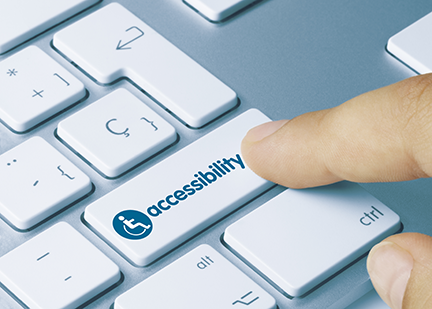ADA Compliance
The Americans with Disabilities Act (ADA) requires certain businesses to make accommodations for people with disabilities. Web content should be accessible to the blind, deaf, and those who must navigate by voice, screen readers or other assistive technologies.
Failure to create an ADA-compliant website could open a business to lawsuits, financial liabilities and damage to your brand reputation.
The process of becoming ADA compliant using Expand Accessibility is very simple
Expand Accessibility is an automated solution with AI-Powered Web Accessibility that configures websites completely accessible in compliance with the WCAG 2.1 guidelines without harming your website's design. Expand Accessibility not only complies with the law but also that it's an ideal solution for those who need it.
- WCAG 2.1, ADA, Section 508, AODA, EN 301549 and IS 5568
- Re-process every 24 hours
- Accessibility statement and certification of performance
- Takes up to 48 hours from initial installation to compliance



A quick and easy 5-minute installation with a single line of JavaScript/plugin installation
Installing Expand Accessibility is extremely quick and simple: all you need to do is implement a single line of JavaScript code to your website. or using our built-in CMS plugins
![]() Built-in plugins and integrations with popular CMS's.
Built-in plugins and integrations with popular CMS's.

Web Accessibility for the blind.
Optimizing websites for screen readers by utilizing AI and image recognition Technologies.
Expand Accessibility utilizes artificial intelligence technologies to make websites compatible with screen readers. It knows how to scan, analyze, and understand a website's structure, element roles, forms and more, making them all compliant with the WCAG 2.1 accessibility standards.
Beyond that, Expand Accessibility's AI provides accurate alternative text descriptions to images (Alt tags) for the screen readers of visually impaired people. This is done by utilizing OCR and IRIS technologies.

Web Accessibility for the Motor Impaired.
Optimization for keyboard navigation used by people with Parkinson's disease and other motor impairments.
People who suffer from Parkinson's have tremors in their hands that affects their ability to use a mouse.
Expand Accessibility automatically ensures that a website is fully navigable using the TAB key alone, including dropdown menus, popups, and forms. Moreover, all navigatable elements are given visible focuses and are clickable using ENTER.

Web Accessibility for the Elderly and People with Cognitive Impairment.
A built-in expression, slang, and phrase dictionary.
Elderly people, people suffering from cognitive impairments, and people who have had brain strokes may find it hard to comprehend sophisticated language, slang, or specific phrases or expressions. This can make it difficult for them to use the internet effectively.
To enhance their experience, Expand Accessibility offers a built-in dictionary that quickly provides a full description of abbreviations and expressions, without transferring to an external website or rephrasing the content itself.

Web Accessibility for People with Epilepsy.
Automatically and immediately stopping blinks and animations of all kinds with the click of a button
People who suffer from epilepsy cannot be exposed to lights and animations that blink or flicker. Therefore, they have a constant fear of using the internet, as almost every website today has a flashing banner meant to grab attention. While these banners are useful in achieving their goal, for people with epilepsy, they are dangerous and likely to provoke a seizure.
Expand Accessibility allows people with epilepsy to immediately halt all types of animations (including but not limited to videos, GIFs, CSS or JS) with a single click, allowing them to browse the web at ease, with no fear.

Web Accessibility for People with Visual Impairments.
Color adjustments for the colorblind, alterations of font size and type, spacing, emphases, large cursors, and more!
People who suffer from visual impairments, such as color blindness, glaucoma, and cataracts, cannot enjoy websites and their content to the fullest. This is true for various reasons, such as experiencing headaches derived from contrast issues, missing buttons due to not being able to see their color, or even not being able to read entire text blocks that are poorly spaced and appear blurry.
Expand Accessibility allows visually impaired people to adjust almost any aspect of a website to their needs. It can increase or decrease font sizes, add or remove spacing between words, letters, or rows, change the font entirely, or even change colors and contrast.



